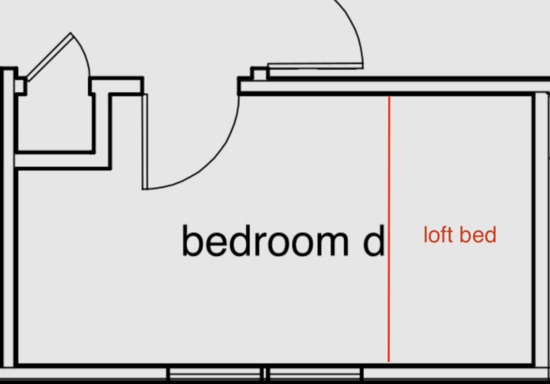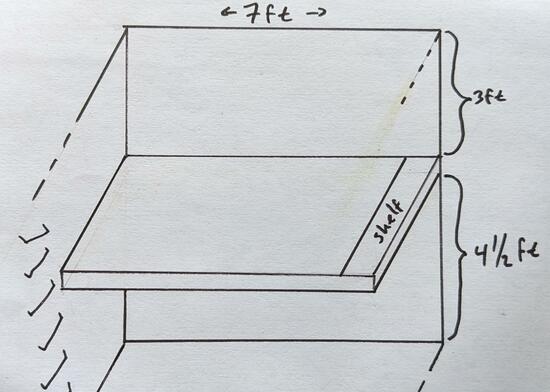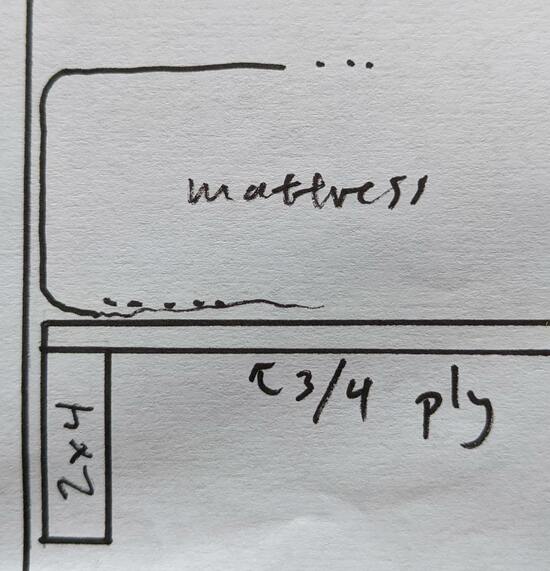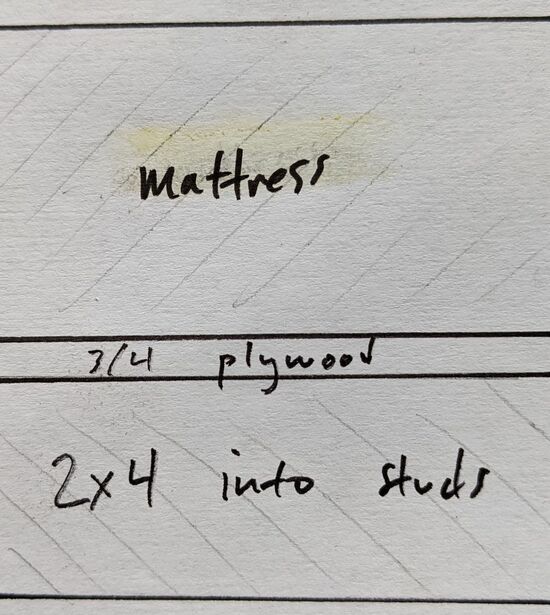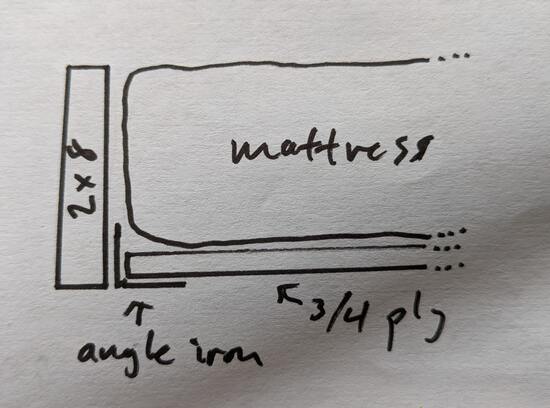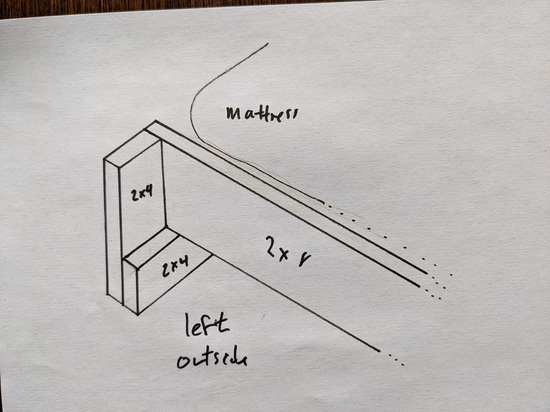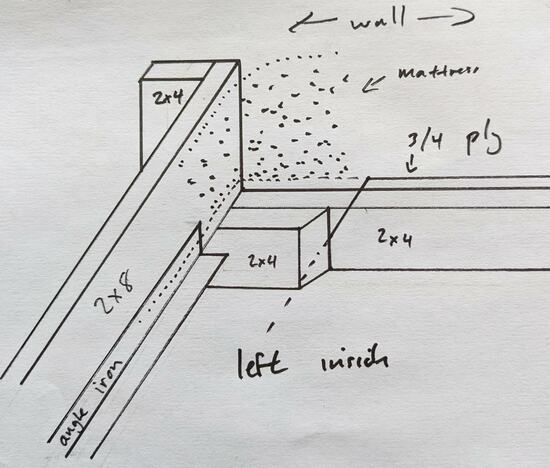Planning a Loft Bed
post by jefftk (jkaufman) · 2022-09-26T00:10:02.026Z · LW · GW · 15 commentsContents
15 comments
The kids have gotten very excited about loft beds. I like the idea as well: they make good use of space. Lily's room, in particular is quite small, 7ft in the shortest dimension. A bed is just a bit shorter than that, so it's a good candidate for a wall-to-wall loft:
Here it is in the room, with a ladder running up the wall:
It would be good to have a bed where even an adult can sit upright. We measured me, and I need just under 36", though I also would sink into a mattress a bit and rarely sit exactly upright. We're currently thinking of doing 36" from the top of the mattress to the ceiling..
Since this is a wall-to-wall design, a simple way to do it is to attach a 2x4 through the drywall into the studs, rest 3/4" plywood on top, and put the mattress on that:
In an area with higher humidity I think you'd want to use bed slats or drill holes in the plywood to help the mattress dissipate moisture, but I don't think this is needed in New England (Julia and I have our mattress on the floor).
This works for the three sides supported by walls, but the third side runs across the room. Something similar to the other three sides would work, except you lose headroom when going under the bed, which is exacerbated by needing a thicker beam for the longer run. Instead, I'm planning on using a 2x8 that's level with the mattress, and 6ft of angle iron to support the plywood:
The 2x8 can be supported by the wall-mounted 2x4s, but it also needs something to keep it from rotating. Here's how I'm thinking of using a few more 2x4 sections to support it:
I'm also planning to make a guard so she doesn't fall out, and attach it to the 2x8. Probably three 2x4s: two vertical and one horizontal.
Materials:
| Price | Material |
|---|---|
| $30 | 6ft 1.5" 14-ga Angle Iron |
| $12 | 8ft 2x8 |
| $60 | 4x8 3/4 plywood cut to 38"x84" |
| $12 | 3x 8ft 2x4s (7ft, 38.5" x2, 10.75" x2, 8" x2, 6ft x1, 18" x 2) |
| ~$12 | Construction screws, 1.5" (angle iron), 3" (attaching 2xs) and 3.5" (attaching to studs). |
| ~$30 | Paint and primer (Soft Turquoise) |
| $160 | Total |
It will actually be a bit cheaper because I already have some of the things that I bought in bulk (fasteners, sandpaper, primer).
I normally wouldn't design quite so much in advance, and plan to figure things out as it went up, but Lily wants it painted. It will be easier to sand, prime, and paint everything in advance instead of fully clearing that side of the room, though I'll probably need to do a bit of touching up after.
This seems like it should be pretty good, though it's hard to say for sure not having tried building it yet.
Comment via: facebook
15 comments
Comments sorted by top scores.
comment by Gunnar_Zarncke · 2022-09-26T10:12:40.421Z · LW(p) · GW(p)
We had a family bed that filled half of one room from wall to wall.
Christopher Alexander has a lot of good recommendations related to loft beds and you seem to have discovered them too:
And about closets mentioned by Dustin he says this:
Replies from: jkaufman↑ comment by jefftk (jkaufman) · 2022-09-26T13:25:23.383Z · LW(p) · GW(p)
I'm pretty strongly disagree about the claim that bedrooms are worthless. They give much better sound isolation than alcoves, which is really important for good sleep.
comment by Dustin · 2022-09-26T01:43:10.160Z · LW(p) · GW(p)
Interestingly, and ridiculously, this bedroom would not pass city code where I live for two reasons:
- 7ft dimension
- No built-in closet.
↑ comment by jefftk (jkaufman) · 2022-09-26T01:48:12.329Z · LW(p) · GW(p)
We built this in 2017 and it passed planning review and inspection in MA. Working with the architect at the time and looking at code to confirm, it needed to be at least 7ft in the shortest direction (it is exactly) and 70sqft (it's more like 80) and there was no requirement for a closet.
Are you sure about 1 and 2?
Replies from: Dustin↑ comment by Dustin · 2022-09-26T02:12:30.771Z · LW(p) · GW(p)
Yeah, I flip houses fairly often and it's something I have to be aware of when remodeling stuff.
I'm sure it's different in different areas.
Replies from: jkaufman↑ comment by jefftk (jkaufman) · 2022-09-26T13:22:39.225Z · LW(p) · GW(p)
What's the minimum horizontal dimension where you live?
(There are also a lot of things which are not a good choice if you are flipping because buyers will not like them, but are not literally illegal)
Replies from: Dustin↑ comment by Dustin · 2022-09-26T16:03:39.880Z · LW(p) · GW(p)
I live/work in a fairly rural area where there are 7 towns with the biggest having a population of ~10k and the smallest ~2k and they all have varying requirements. I've had conversations with the single code enforcement officer or director in each of them and we all agree how aggravating it is that the requirements vary from town to town. Three of these towns butt right up next to each other so the code requirements can vary from one side of the street to the next!
Contrary to what I would expect, the biggest town, and the county seat, has by far the fewest regulations on homes of them all.
Anyway, of the two which enforce anything about bedroom dimensions it's 9' for smallest allowable dimension. I think only one of them requires closets, but I can't recall for sure.
Your parenthetical requirement reminded me of two things:
- I think more people should be thinking about resale when building/remodeling their home. You never know what the future holds!
- Since we rent out houses as well, I always aim for HUD compliance. HUD requires closets in bedrooms. While HUD doesn't require 10x10, I know the three people at HUD who handle the surrounding 3 counties worth of HUD voucher recipients and they all strongly recommend it and steer clients towards such properties. (though currently they're hurting for properties, so they're more likely to not turn their nose up at <10' dimensions)
comment by jm25 · 2022-09-26T09:08:34.235Z · LW(p) · GW(p)
Looks cool! I remember being excited about these when I was a kid.
Could you share some details on how you make those drawings which aren't just cross-sections? I do some basic construction but I don't have any training in it and my drawing skills suck but I'm not sure where to start.
Replies from: Dustin, jkaufman↑ comment by jefftk (jkaufman) · 2022-09-26T13:21:57.033Z · LW(p) · GW(p)
-
Rough sketch freehand with a pencil to get a sense of how the things fit together.
-
With that as a reference I make something with a pencil and a ruler. In this step I draw every line, even for ones that should be included, and I'm careful not to press too hard.
-
Pen and ruler, inking the lines that should be on top.
-
After the ink has dried, I lightly go over it with an eraser to remove any stray pencil lines.
↑ comment by jm25 · 2022-09-27T09:54:49.655Z · LW(p) · GW(p)
Thanks! That's useful to know, but I was asking more about the ability to draw a '3d' perspective sketch. Whenever I try to do this it just ends up looking a mess and things aren't the right relative size.
Did you ever take a technical drawing class or anything? Or is this a thing some people can just do?
Replies from: philh, jkaufman↑ comment by philh · 2022-10-02T12:55:46.131Z · LW(p) · GW(p)
If having a name helps: the first one looks like isometric projection.
It's probably not very sensitive to getting the angles exact, if you don't need exact lengths either. But when I was taught to draw like that in school (some time between ages 11 and 14) we used paper with a dotted triangular grid, I think something like this, to get them without measuring.
↑ comment by jefftk (jkaufman) · 2022-09-27T10:45:29.566Z · LW(p) · GW(p)
One way what I'm doing here is a bit easier is that I'm not actually doing a perspective sketch. This is a parallel projection, where parallel lines in reality remain parallel in the drawing. That means it doesn't look exactly like anything you might actually see, but it's close and much easier to draw.
The style of the second drawing is a bit easier than the first. You start by sketching everything that's in one plane, with vertical lines vertical and horizontal lines that are perpendicular to you horizontal. To make things the right size you can use a ruler and pick some a scale: 1 inch to the foot or something. Then when you need to draw a horizontal lines that are "coming out of the page" instead make them at an angle. Exactly which angle you choose doesn't matter that much, but once you've picked that angle you should make sure anything else parallel uses exactly the same angle.
I haven't taken a class, but this also isn't something I was born able to do. Just lots of doing it until I have results I like.
Replies from: jkaufman↑ comment by jefftk (jkaufman) · 2022-10-02T13:42:02.885Z · LW(p) · GW(p)
Follow up: https://www.jefftk.com/p/how-i-make-diagrams
